As your business scales, your marketing team will grow and evolve too.
While this growth is happening, it’s important to maintain reliable avenues for collaboration and communication on your marketing team. Otherwise, your business won’t be able to perform at the highest level. The good news is that marketing collaboration software can help with this.
In this article, we’ll cover what marketing collaboration software is, why it’s important, and 20 of the best tools currently on the market.
Marketing Collaboration Software
Marketing collaboration software helps marketing teams maintain easy communication, manage projects and campaigns, prioritize tasks, establish schedules and editorial calendars, promote organization and productivity, and more.
Why is marketing collaboration software important?
No matter which industry your business is in, what size your team is, whether you’re in-office, remote, or a mix of both, marketing collaboration can help your team improve in a number of areas — all of which impact your bottom line. Some examples include improved and streamlined…
- Communication
- Teamwork
- Productivity
- Organization
- Efficiency
- Task management
- Scheduling
- Data sharing
- Transparency
- Content creation
Marketing Collaboration Features
Here are some common features found across many marketing collaboration tools today.
- Group communication
- Shared files, documents, calendars, notes, and other assets
- Task management and time/ progress tracking
- Document management
- Campaign management
- Editorial calendar
- Content creation capabilities
- Content, file, and data organization
- Integrations (to connect the marketing collaboration software to your other marketing and business tools)
- Audio and video conferencing
- Marketing automation
- Reporting and analytics
Marketing Collaboration Software
Here are 20 of the best marketing collaboration software available today.
1. HubSpot Marketing Hub
HubSpot Marketing Hub is a marketing automation platform that allows you to attract your target audience, convert website visitors, and run inbound marketing campaigns at scale. Marketing teams can seamlessly collaborate to plan and execute large-scale, omnichannel marketing campaigns.
Marketing Hub also allows for frictionless collaboration with other teams — such as sales — in order to offer delightful customer experiences. This is known as CRM-powered Marketing — HubSpot makes it possible by pairing marketing automation tools with an all-in-one CRM platform.
2. Slack
Slack is a platform that allows for easy communication and collaboration on any scale. Slack Channels serve as central communication areas where you and your team can chat with one another and share relevant information, files, tools, and more.
Send messages via chat, host video calls, or speak with your team via voice call all without leaving the tool. There are also over 2,200 integrations and apps, such as Google Drive and Office 365, to help your team streamline workflows.
Additionally, the Slack Connect feature makes it possible to communicate and collaborate with teams at other companies the way you do with your own.
3. Trello
Trello is a collaboration and productivity tool for managing, tracking, and sharing work projects and tasks. The tool organizes your work into Kanban-style lists — that means your work is separated into categories for an easier workflow (such as to-do, work in progress, and complete).
Your team can communicate and tag each other on each project card, share and attach files, add due dates, move cards into different Kanban-style lists to track work, and archive cards once they’re complete.
4. Asana
Asana is a task and project management platform that allows both remote and distributed teams to organize and manage work. Teammates can collaborate on project lists, timelines, or boards, all of which have individual tasks and stages that you can customize, share, and archive. The tool’s messaging feature makes it easy to distribute, assign, and manage work.
Automate various project management tasks to save your team time and integrate your tool with one of 100+ apps that bring together all of your work to improve collaboration and coordination across your team.
5. Monday.com
Monday.com is a work operating system and project management tool that allows you to create workflows for any project. There are over 200 templates workflows available that marketing can use, as well as other departments such as IT, sales, design, web development, operations, and HR and recruiting.
Your team can manage and collaborate on all aspects of a project from a single location. The 200+ templates mentioned above are completely customizable and allow all team members to visualize your project, and its different stages, in a way that’s preferable to your team (e.g. map, calendar, timeline, Kanban-style list).
You can also integrate Monday.com with your other tools and apps to access and manage all parts of your projects and campaigns without leaving the tool.
6. Teamwork
Teamwork is a collaborative project management software meant for managing and delivering client work on time and on budget. You can simultaneously manage multiple projects of varying complexity with Teamwork’s Board View, dashboards, and project health status updates.
Hold all team members accountable for their part of a project or campaign by assigning responsibilities and using time tracking to determine how long certain tasks are taking.
7. CoSchedule
Rather than collaborating and handling your marketing via various spreadsheets, tools, calendars, and emails, CoSchedule’s actionable Marketing Calendar is where your team can see, schedule, and share all aspects of your marketing jobs and campaigns.
You can also share your calendar in a read-only format so higher-ups and other teams can view your project plans and trajectory without having to worry about someone accidentally making an edit.
8. Evernote Teams
Evernote Teams is a collaborative note-taking app ideal for managing, arranging, and organizing your thoughts, ideas, to-do lists, and more. The tool makes it easy to collaborate, sync, and share knowledge, as well as ensure progress is being made on certain projects and tasks.
Evernote’s Spaces provide visibility into progress on team projects as well as relevant workflows and documents. You can make, leave, and search across Spaces for notes and notebooks that you created or other team members created.
9. Sharelov
 Sharelov is a cloud-based marketing collaboration platform for brands and agencies to manage their teams, campaigns, assets, projects, and work. No matter what you’re working on or what your creative assets include, Sharelov makes it easy to collaborate, share feedback, and approve assets, plans, and projects.
Sharelov is a cloud-based marketing collaboration platform for brands and agencies to manage their teams, campaigns, assets, projects, and work. No matter what you’re working on or what your creative assets include, Sharelov makes it easy to collaborate, share feedback, and approve assets, plans, and projects.
Use the tool to establish your teams, improve ease of collaboration within those teams, and track team and individual progress in real-time. Team members can provide feedback for each other for every creative — this simplifies the process of managing internal and client feedback and change requests across individual projects.
10. Acoustic
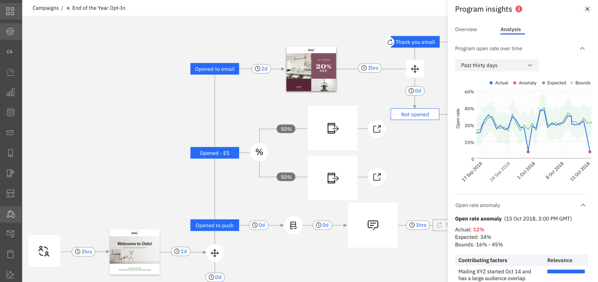
Acoustic is a digital marketing experience platform — the platform’s Marketing Cloud tool helps you better understand your customers and their behaviors at scale.
Acoustic allows your entire marketing team to manage and collaborate on campaigns, content, insights, and personalization, all via a single tool. There are AI-powered analytics and insights features to help you understand customer behaviors and experiences.
11. Zoom
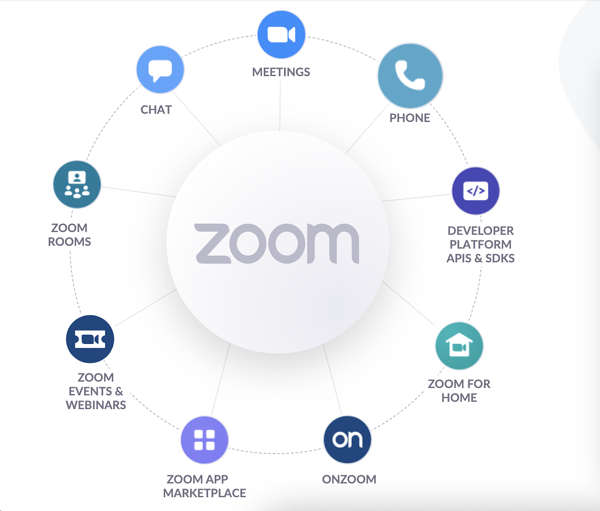
Zoom is a video conferencing, cloud phone, webinar, and online events software. It makes team collaboration and communication easy, no matter the industry or whether your team is in office, remote, or a mix of both.
Use one of Zoom’s many available integrations to connect the software with your other business tools (e.g. HubSpot, Google Workspace, Slack, etc.).
Host Zoom Webinars or Events depending on the level of collaboration and engagement you’re looking for. You can also follow up on a discussion topic, share links, or communicate with others in real-time using Zoom’s Chat feature.
12. Lucid Chart

Lucid Chart is an intelligent diagramming software that makes it easy for teams to collaborate on the visualization of complex ideas related to your team’s processes, systems, and organizational structure.
Individuals and teams can map out progress around a certain task and determine what needs to be done next and what’s missing. Then your team can align on and apply all resulting insights using Lucid Chart’s common visual language, which streamlines collaboration.
You can also use Lucid Chart to create, manage, and collaborate on business process maps, user flows, cloud architecture diagrams, scrum teams, and data flows.
13. Canva
Canva is a graphic design and publishing tool that allows your team to collaboratively plan, design, create, publish, and share a variety of content types including logos, social media posts, documents, graphs and charts, prints, and more.
The tool makes it easy to invite team members to review and edit designs via shareable links, email, or Canva folders. Canva also ensures your team has everything they need to use brand-ready and team-approved assets — there’s a Brand Kit feature where your team can establish and save templates, fonts, colors, images, logos, and more.
14. Click Up
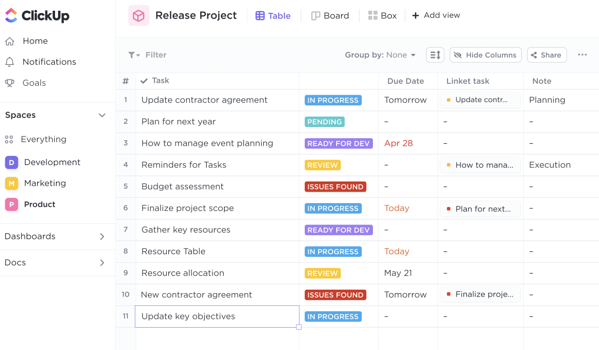
Click Up is a cloud-based collaboration and project management tool that aims to bring all of your team’s work — docs, chat, goals, insights, and tasks — together in one place.
Within Click Up, your team can establish, refer to, collaborate on, and customize all aspects of every project including to-do lists, wikis and documents, emails, spreadsheets, events, reminders, goals, time-tracking, screenshots, recordings, resource management, and more.
Then, organize these project elements into one of 15 different views (e.g. list, box, mind map, Gantt) based on your team’s needs and preferences.
15. Funnel.io
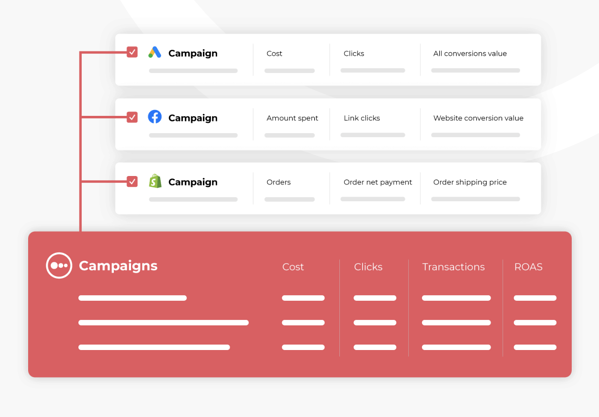
Funnel.io is a data mapping and collection tool — it transforms collected data into automated marketing reports for your team to analyze, share, and build off of.
Once you connect all of your data sources — a process that Funnel.io makes easy with its over 500 marketing app integrations — it will be cleaned, organized, and mapped for you.
Then, decide where you want your finalized data and reports to go — whether in Google Data Studio, a data warehouse of your choosing, Google Sheets, etc. There, your entire team can identify insights and collaborate on how you’ll apply the information.
16. Domo
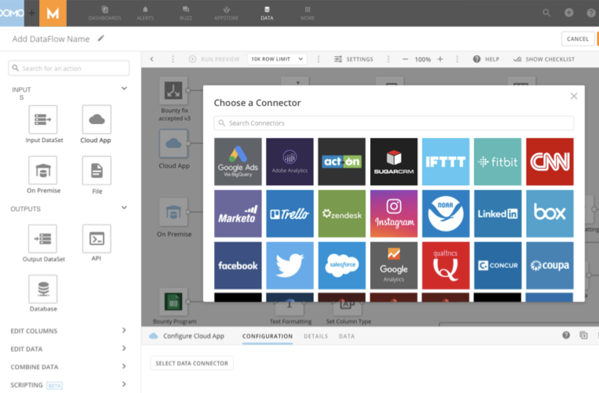
Domo for Marketing combines your marketing team’s data with data from sales, finance, and other departments within your company so you’re able to increase transparency, improve collaboration, and maximize ROI across the company.
Data visualizations and predictive analytics and alerts help marketers identify and pull out the most important insights from the data.
Set alerts for data that deviates and/or hits your goals to accurately track progress. Your team can then create real-time visualizations of data (without any code), and access and collaborate on those insights via any device.
17. Dropbox
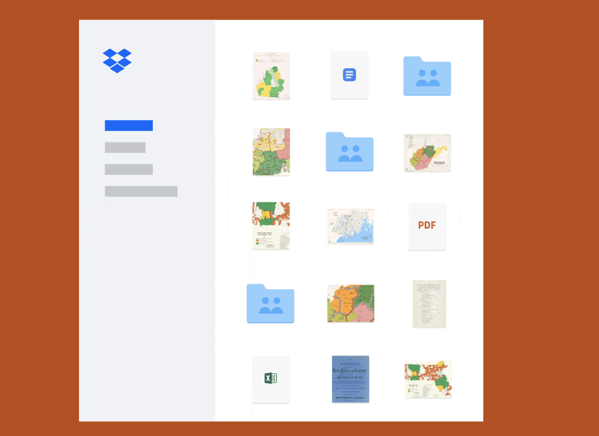
Dropbox is a file hosting software that centralizes your team’s content and tools. It gives your team secure access to all of your files via one location. Your marketing team can collaborate with each other in Dropbox by storing, organizing, sharing, referencing, and downloading files.
Use the tool to manage team tasks, track file updates, and remain in contact with team members and even clients on projects. You can also deliver completed projects to higher-ups, other teams, or clients — whether they’re large files or a collection of files — with passwords, expiration dates, and delivery confirmation.
18. Wrike
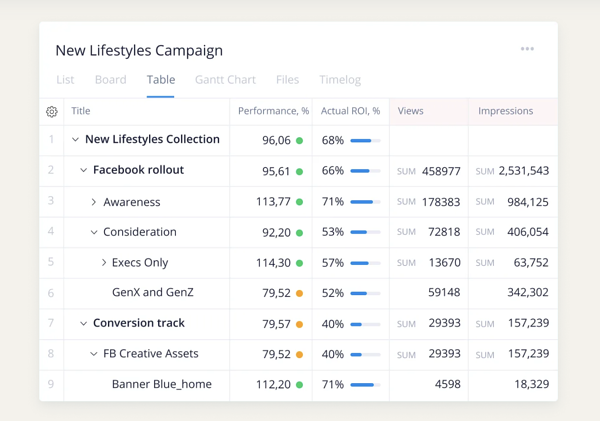
Wrike is a project management software with features meant for increasing transparency and improving team-wide as well as cross-departmental collaboration. It allows you tocollaborate on work in real-time — no more communication across various channels such as email, meetings, and instant messages.
No matter the project, your team can use Wrike to make comments, edit work, set notifications, and build reports, and share insights with each other — all in real-time. You can also view your individual tasks, the responsibilities of other team members, as well as the status of specific projects to track progress.
19. Google Drive
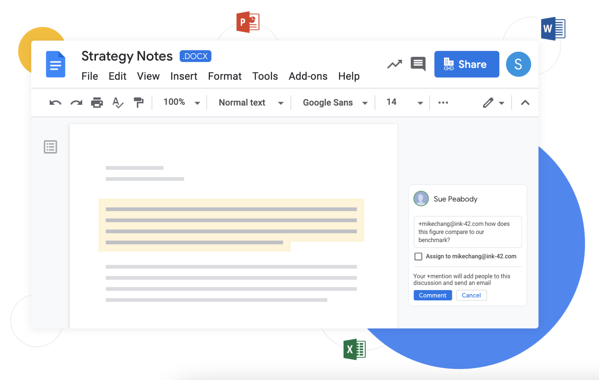
Google Drive is secure, cloud-based storage software that allows you to store, share, and access files and folders — from Google Docs, Sheets, Slides, and more — via your mobile device, tablet, and computer.
Once you upload your content or files to Google Drive, you can create a shared folder for them to live in — this way, your team can access and collaborate on anything in the folder.
Edit and add comments to any of the files in the shared folder in real-time — if your team members aren’t already in the Doc, Slides, or Sheet, they’ll still receive an email notification about your edits or comments. You can also review the edit history on any of your files. And it’s alright if your files aren’t Google files — that’s because the platform supports over 100 file types including Microsoft Office.
20. Brightpod for Marketing
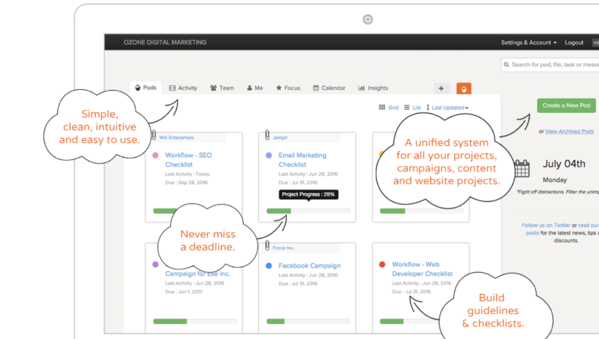
Brightpod is a tool that simplifies marketing collaboration and planning — it’s a project management and time tracking software meant for digital marketing and creative teams.
The tool provides clarity around your team’s projects, campaigns, tasks, workflows, and deadlines. Individual teams can collaborate with each other as well as reference and communicate about other projects that are going on across the team via a single dashboard.
All projects that are listed on your dashboard have milestones and tasks so everyone on the team knows what’s expected of them what progress on each task looks like.
Grow Better With Marketing Collaboration Software
Marketing collaboration software can help your team easily communicate, manage projects, prioritize tasks, organize content, and more. Start using one of these tools to increase team-wide productivity and teamwork.
Editor’s note: This post was originally published in September 2014 and has been updated for comprehensiveness.
![]()



